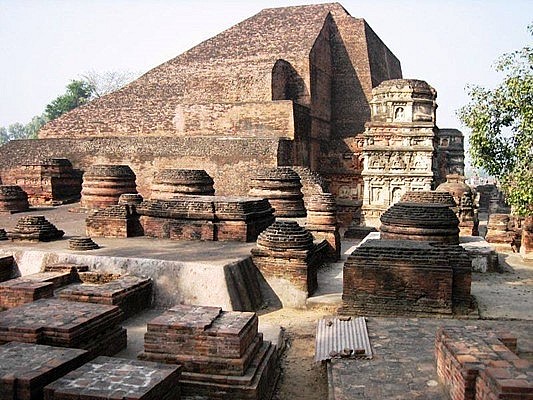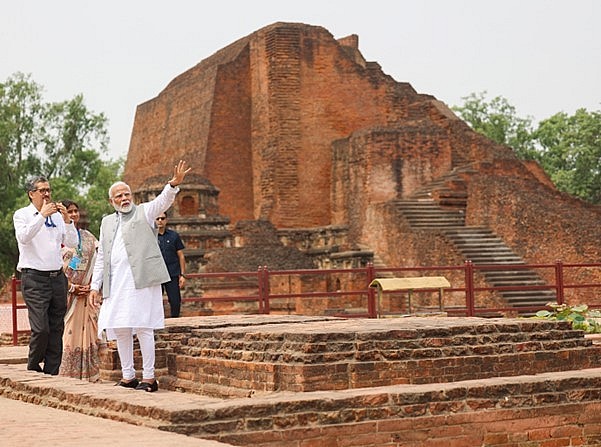World's first residential university Nalanda's revival reconnects India's illustrious past with ASEAN and more
 |
After unveiling the campus on Wednesday (June 19) amid the presence of a large number of envoys of other countries, especially ASEAN, PM Modi said a golden era of India will begin with the rebuilding of the ancient university.
“Nalanda is more than just a name, it’s a mantra, an identity, a declaration that books might get destroyed by fire, but knowledge endures," Narendra Modi said. "The revival of Nalanda will mark the beginning of the Golden Age of India."
Highlighting the historical significance of Nalanda, the Indian Prime Minister said it symbolizes the renaissance of the country’s past and reflects the heritage of various countries, including those in Asia.
“Nalanda was once the epicentre of India’s educational identity. Education goes beyond the realms of borders, profits and losses. Education shapes our thoughts and behaviour," he said.
"During ancient times, admission to Nalanda University was not based on the nationality of the student. People from different walks of life used to come here in pursuit of education,” PM Modi added.
 |
| PM visits the Ruins of Nalanda, in Bihar on June 19, 2024 |
Besides Union Minister for External Affairs S Jaishankar and Bihar Chief Minister Nitish Kumar, Ambassadors of 17 partner countries were also present at the event.
According to reports, the attendees include representatives from ASEAN (Association of Southeast Asian Nations) countries such as Australia, Bangladesh, Bhutan, Brunei, Cambodia, China, Indonesia, Laos, Mauritius, Myanmar, New Zealand, Portugal, Singapore, South Korea, Sri Lanka, Thailand, and Vietnam, all of whom have signed memorandums of understanding (MoU) in support of the university.
The modern Nalanda University was re-established in 2010 through a legislative act by the Indian Parliament, marking a significant reawakening of Nalanda Buddhist mahavihara (great monastery) -- the world's first residential and second-oldest university after Takshashila.
Before that, a proposal to establish the international university, on the lines of its namesake and ancient site of learning that functioned till the 13th century, was endorsed by member countries at the 4th East Asia Summit held in Thailand's Cha-am Hua Hin in 2009.
The revival of the historic university gained momentum in 2006 when the then President of India, late A P J Abdul Kalam, proposed its re-establishment during his address to a joint session of the Bihar State Legislative Assembly.
By September 2014, the first batch of students had enrolled, marking Nalanda University's rebirth.
Later, the State Government of Bihar reportedly allocated 455 acres for the new campus, setting the stage for its renaissance, media reports said.
Welcoming India’s initiative to revive the Nalanda University, the ASEAN member nations during the 4th East Asia Summit noted that the historic university was a great ancient centre of intellectual activity in Buddhist philosophy, mathematics, medicine and other disciplines, according to a joint press statement of the summit.
As per the media statement, the ASEAN member nations were deeply impressed with the sanctity and significance of the great ancient centre of learning in Nalanda that attracted many scholars from South, South-East and East Asia.
According to historical data, Nalanda, which thrived as a beacon of knowledge, in those days boasted an impressive roster of 2,000 teachers and 10,000 students from far-flung regions like China, Korea, Japan, Tibet, Mongolia, Sri Lanka, and Southeast Asia.
The ancient university's architectural design of open courtyards flanked by prayer halls and lecture rooms inspired Buddhist institutions across Asia, while its influence extended to the ecclesiastical art of Thailand and the metal artistry of Tibet and the Malayan peninsula.
The ASEAN member countries appreciated the contribution and recommendations made by the members of the Nalanda Mentor Group headed by Nobel Laureate Amartya Sen towards the establishment of the Nalanda University, as per the joint statement.
They also supported the establishment of the Nalanda University as a non-state, non-profit, secular, and self governing international institution with a continental focus that will bring together the brightest and the most dedicated students from all countries of Asia – irrespective of gender, caste, creed, disability, ethnicity or social-economic background – to enable them to acquire liberal and human education and to give them the means needed for pursuit of intellectual, philosophical, historical and spiritual studies and thus achieve qualities of tolerance and accommodation, the media statement read.
Nalanda, which is considered to be among the greatest centres of learning in the ancient world, was a hub of diverse intellectual pursuits, with Ayurveda -- the ancient Indian medical system -- being widely taught, though the institute's most enduring legacy lies in its monumental contributions to mathematics and astronomy as the father of Indian mathematics, Aryabhata, is speculated to have headed the university in the 6th century CE.
According to a report by Moneycontrol, admission to the ancient Nalanda was very challenging as prospective students had to undergo rigorous oral interviews with the university's top professors.
The successfully inducted students were tutored by an eclectic group of scholars under revered Buddhist masters such as Dharmapala and Silabhadra.
Nalanda's library, with nine million handwritten palm-leaf manuscripts, was the world's richest repository of Buddhist knowledge.
Known as “Dharma Gunj,” or the “Mountain of Truth,” Nalanda's library was a treasure trove of Buddhist scriptures, scholarly notes, and curriculum books spanning a vast array of subjects, as reported by Moneycontrol.
Tragically, Nalanda met a fiery end at the hands of Muhammad Bakhtiyar Khilji, a Turko-Afghan military general determined to extinguish this Buddhist center of learning, in the 1190s.
The university was rediscovered in 1812 by Scottish surveyor Francis Buchanan-Hamilton and later identified as the ancient university by Sir Alexander Cunningham in 1861, according to reports.
During 1920-1921, archeological excavations in the site discovered a thick layer of ashes on the uppermost strata, across many buildings separated by some distance, which suggests that Nalanda was subject to a catastrophic fire.
Traditionally, this is held to be arson, blamed upon the troops of Khalji who had plundered the region 1200 CE.
However, the new campus of Nalanda University, designed by the celebrated architect Padma Vibhushan late BV Doshi, merges eco-friendly architecture with ancient Vaastu principles, creating a net-zero carbon footprint green campus spread over lush greenery and 100 acres of water bodies.
The new campus features two academic blocks with 40 classrooms accommodating nearly 1,900 students, two administrative blocks, two auditoriums with a combined seating capacity of over 300, and hostels housing up to 550 students.
The residential area of the university includes 197 academic housing units, ensuring comfort and convenience for faculty and students alike, as per reports.



